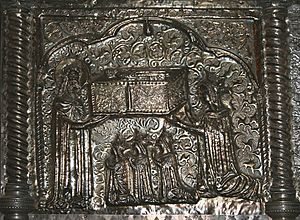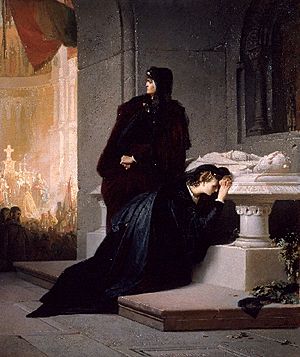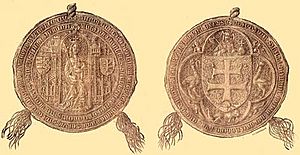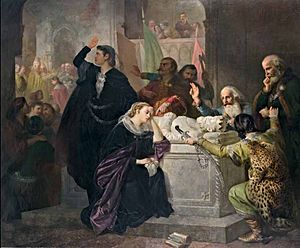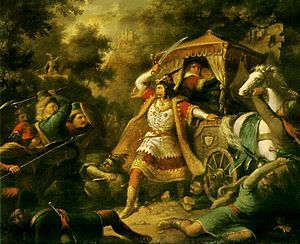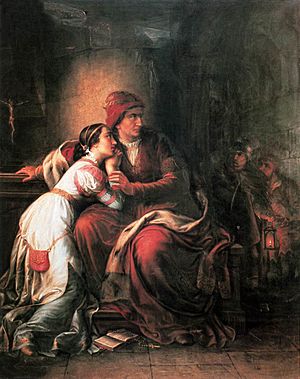Mary, Queen of Hungary facts for kids
Quick facts for kids Mary I |
|
|---|---|

Mary as depicted in the Chronica Hungarorum
|
|
| Queen of Hungary and Croatia with Sigismund (1387–1395) |
|
| 1st reign | 1382–1385 |
| Coronation | 17 September 1382 |
| Predecessor | Louis I |
| Successor | Charles II |
| Regent | Elizabeth of Bosnia |
| 2nd reign | 1386–1395 |
| Predecessor | Charles II |
| Successor | Sigismund |
| Born | 1371 |
| Died | 17 May 1395 (aged 23–24) Buda, Kingdom of Hungary |
| Burial | Várad (now Oradea) |
| Spouse | Sigismund of Luxembourg |
| House | Capetian House of Anjou |
| Father | Louis I of Hungary |
| Mother | Elizabeth of Bosnia |
Mary (1371 – 17 May 1395) was a powerful Queen who ruled Hungary and Croatia. She was also known as Maria of Anjou. Mary became queen in 1382 after her father, Louis the Great, died. She was the daughter of Louis the Great, who was King of Hungary and Poland, and his wife, Elizabeth of Bosnia.
Even before Mary was one year old, it was decided she would marry Sigismund of Luxembourg. He was a member of the important Luxembourg dynasty. In 1379, Polish leaders agreed that Mary could become queen of Poland after her father.
Mary was crowned "king" of Hungary on 17 September 1382. This was just seven days after her father's death. Her mother, Queen Elizabeth, became the regent, meaning she ruled for Mary. In 1383, Mary's mother let the Polish nobles break their promise to Mary. Instead, they supported Mary's younger sister, Jadwiga, for the Polish throne.
Many Hungarian nobles did not like the idea of a female ruler. Most of them thought Mary's distant cousin, Charles III of Naples, should be the king. To make Mary's position stronger, her mother wanted her to marry Louis, the younger brother of Charles VI of France. Their engagement was announced in May 1385.
Charles III of Naples arrived in Dalmatia in September 1385. At the same time, Sigismund of Luxembourg invaded Upper Hungary (which is now Slovakia). This forced Mary's mother to let Mary marry Sigismund in October. But they could not stop Charles from entering Buda. Mary gave up her throne, and Charles was crowned king on 31 December 1385. However, he was killed in February 1386 because Mary's mother arranged it.
Mary became queen again, but Charles's supporters captured her and her mother on 25 July 1386. Queen Elizabeth was killed in January 1387. Mary was finally set free on 4 June 1387. Mary officially ruled with Sigismund, who had been crowned king. But Mary had very little power in the government. She died in May 1395, along with her baby son, after falling from her horse during a hunting trip.
Contents
Early Life and Royal Plans (1371–1382)
Mary was born in 1371. Her parents were Louis the Great, King of Hungary and Poland, and his second wife, Elizabeth of Bosnia. Mary was their second daughter. Her older sister, Catherine, was born in 1370. Mary and Catherine got another sister, Jadwiga, in 1374.
King Louis had no sons. This meant his daughters would inherit his kingdoms of Hungary and Poland. They would also inherit his claims to the Kingdom of Naples and Provence. This made them very desirable brides for other royal families in Europe.
Before Mary's first birthday, her father promised Charles IV, Holy Roman Emperor, that Mary would marry Charles's second son, Sigismund of Luxembourg. King Louis confirmed this promise in June 1373. Mary and Sigismund were related. Mary's grandmother, Elizabeth of Poland, was the sister of Sigismund's great-grandfather. Pope Gregory XI gave special permission for their marriage in December 1374. Important Hungarian and Polish lords agreed to Mary and Sigismund's marriage in April 1375.
Mary's older sister, Catherine, died in 1378. She had been promised to Louis of France. In 1379, King Louis the Great confirmed Mary's marriage promise to Sigismund. Sigismund had become the Margrave of Brandenburg and came to Hungary.
In September 1379, King Louis gathered Polish religious leaders and lords. He convinced them to accept Mary as his successor in Poland. Some records say the Poles only agreed after Louis prevented them from leaving the town. In early 1380, Louis hinted that he might give Hungary to his younger daughter, Jadwiga. She was engaged to William. On July 25, 1382, Polish nobles again honored Sigismund and Mary. Some historians believe Louis wanted to divide his kingdoms between his two daughters. Others think he wanted Mary and Sigismund to rule both Hungary and Poland.
Becoming Queen of Hungary
Early Challenges (1382–1384)
Louis the Great died on September 10, 1382. Cardinal Demetrius of Esztergom, a high church official, crowned Mary "king" of Hungary. This happened on September 17, just after her father's burial. Mary was crowned quickly and without Sigismund. This showed that her mother wanted Mary to be the main ruler.
Mary's mother, Queen Elizabeth, became the regent. She ruled on Mary's behalf. Nicholas Garai and Cardinal Demetrius were her main advisors. Most of Louis's officials kept their jobs. However, Queen Elizabeth removed two brothers, George and Peter Czudar. They were accused of being disloyal.
All official papers from Mary's first six months as queen said she had legally inherited her father's crown. But many Hungarian nobles did not like having a female ruler. They thought Charles III of Naples was the rightful king. Charles was the last male from the Capetian House of Anjou family. Charles could not openly claim Hungary at first. This was because his rival, Louis I, Duke of Anjou, had invaded Southern Italy.
Polish nobles offered to support Mary or Jadwiga in November. But they said the queen and her husband must live in Poland. In February 1383, Queen Elizabeth sent people to Poland. They told the Poles they no longer had to be loyal to Mary. Instead, Queen Elizabeth would send her younger daughter, Jadwiga, to Poland.
In the spring of 1383, John of Palisna, a powerful leader, started a rebellion against Mary and her mother. The royal army went to Croatia and attacked Vrana. John of Palisna had to run away to Bosnia. The people defending Vrana gave up to Mary on November 4. Mary had been there with her mother during the attack.
To make Mary stronger against Charles of Naples, Queen Elizabeth sent people to France. They started talking about Mary marrying Louis of France. He was the younger brother of Charles VI of France. Mary and her mother left Croatia and Slavonia early the next year.
In May 1384, Queen Elizabeth replaced Stephen Lackfi. She accused him of being a traitor. She also sent letters telling people not to support Lackfi and his friends. The queens held a meeting of nobles, called a Diet. Mary confirmed her father's old laws that protected the nobles' rights.
The talks about Mary marrying a French prince caused problems among the Hungarian nobles. Some important officials still supported Sigismund, Mary's first fiancé. They believed this was what Louis the Great wanted. In August 1384, the queen mother replaced these officials with people who supported Nicholas Garai. Church leaders also did not like the French marriage. This was because the French supported a different pope than the one Hungary recognized. Mary's sister, Jadwiga, went to Poland and was crowned queen on October 16, 1384.
The Threat from Naples (1384–1385)
Louis I of Anjou died on September 10, 1384. This allowed his rival, Charles III of Naples, to become stronger in Southern Italy. Charles III's growing power led some Hungarian nobles to support his claim to the Hungarian throne. John Horvat and his brother, Paul, were key leaders of this group.
Sigismund of Luxembourg tried to convince the queen mother to let him marry Mary. But she refused. He left Hungary in early 1385. The queens tried to make peace with the nobles who supported Charles. But they could not agree at a meeting in Požega in the spring of 1385.
After a French group came to Hungary in May 1385, Mary became engaged to Louis of France. Louis of France then started signing his letters as "Louis of France, King of Hungary." In the same month, the queen mother fired Stephen Lackfi, saying he was a traitor.
John and Paul Horvat and their friends officially offered the crown to Charles III of Naples. They invited him to Hungary in August. Sigismund stormed into Upper Hungary with his cousins and took control of some areas. The queen mother changed some officials again.
Charles III of Naples landed in Dalmatia in September 1385 and marched to Zagreb. Sigismund of Luxembourg came to Buda. He convinced the queen mother to let him marry Mary. The wedding happened in Buda in October. But Sigismund was not crowned king and did not get any government job. The queen mother called a new meeting of nobles. Mary again confirmed the nobles' freedoms. But the queens' rule was still not popular. Sigismund left Buda. Charles of Naples had left Zagreb, saying he wanted to bring peace to Hungary.
Charles Takes the Throne (1385–1386)
Many nobles joined Charles of Naples as he marched toward Buda. Mary and her mother greeted him formally before he reached Buda. He entered the capital with the two queens in early December 1385. Mary gave up the crown without fighting in mid-December. She was afraid Charles would harm her. Charles first called himself governor. But the meeting of nobles elected him king. Charles was crowned king of Hungary on December 31 in Székesfehérvár. Mary and her mother were there. They visited Louis the Great's tomb and cried because of their bad luck.
Charles did not imprison Mary and her mother. They continued to live in the royal palace in Buda. Queen Elizabeth and Nicholas Garai decided to get rid of Charles. They convinced Blaise Forgách, an official, to help them. They promised him land if he killed the king. On February 7, 1386, Charles visited the queens at Queen Elizabeth's request. During the meeting, Blaise Forgách attacked the king. He seriously hurt Charles's head. The wounded King Charles was taken to Visegrád. He died there on February 24.
Mary Returns to Power and Is Captured (1386–1387)
Mary became queen again, with her mother ruling for her. The queen mother told people on February 14 that "Queen Mary had regained the Holy Crown." However, the Horvat brothers started a rebellion. They supported the murdered king's son, Ladislaus of Naples. Mary's husband, Sigismund, and his brother invaded Upper Hungary in April.
After weeks of talks, the queens agreed to Sigismund's role as co-ruler. They signed a treaty in Győr in early May. They also confirmed Sigismund's deal to give some lands to his cousins. After the treaty, the queens went back to Buda. Sigismund went to Bohemia, which suggests he was not happy with the agreement.
Queen Elizabeth decided to visit the southern parts of the kingdom. These areas were controlled by supporters of Ladislaus of Naples. The queen mother and Mary left for Đakovo around July 15. Nicholas Garai and a small group went with them. However, John Horvát and his men attacked the queens and their group on July 25. The queens' small group fought, but everyone was killed or captured. Blaise Forgách and Nicholas Garai were executed. Queen Elizabeth took all the blame for the rebellion. She begged the attackers to spare her daughter's life.
Mary and her mother were put in prison. They were held in Gomnec Castle. This was a fortress of the Bishopric of Zagreb. While the queens were away, the nobles called a meeting. They promised a general pardon in Queen Mary's name. But the Horvats refused to give up. The two queens were moved to Krupa, and then to Novigrad Castle on the Adriatic Sea. The nobles elected Stephen Lackfi as a high official. They made Sigismund of Luxembourg the regent. John Horvat's men killed Queen Elizabeth in early January 1387. In the same month, Sigismund invaded Slavonia, but he could not defeat the rebels.
Polish troops invaded Lodomeria and Halych in February. This was because of the chaos in Hungary. Only Vladislaus II of Opole protested. Sigismund was crowned king on March 31. It was decided that the kingdom needed a strong ruler. One of Sigismund's supporters, Ivan of Krk, attacked Novigrad Castle. He had help from a Venetian fleet. They captured the castle and freed Mary on June 4, 1387. Mary was very thankful to the Venetian commander. She made him a knight and gave him money every year.
Ruling with Her Husband (1387–1395)
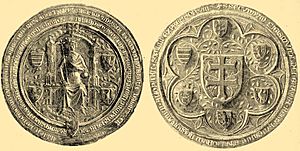
Mary met her husband, Sigismund, in Zagreb on July 4. She officially remained his co-ruler until she died. But Mary had very little power in the government. For the first year of their rule, Sigismund's land gifts were always confirmed with Mary's own royal seal. But after that, people rarely asked for her confirmation. Official papers counted her years as queen from her husband's coronation, not from when she first became queen.
However, Mary did convince her husband to punish John Horvat. John Horvat was captured in July 1394. Sigismund would have let him live, but Mary insisted he be executed.
Mary was pregnant when she decided to go hunting alone in a Buda forest on May 17, 1395. Her horse tripped, throwing her off and landing on top of her. The accident caused her to go into labor early. She gave birth to a son too soon. The queen died from her injuries. Since she was far from help, her son also died. She was buried in the cathedral of Várad (now Oradea in Romania). Mary's sister, Jadwiga, claimed the Hungarian crown. But Sigismund kept it without much trouble.
See also
 In Spanish: María I de Hungría para niños
In Spanish: María I de Hungría para niños


